The Wright brothers’ next airplane design were the gliders of 1902. These machines were one of the most direct results of the 1899 kite. Indeed, many of the tests on these machines were in flying the glider as a kite, so that the Wrights could make accurate measurements of the gliders’ performances under known conditions. The resulting analyses of these tests were crucial in the Wrights’ developing understanding of aerodynamics.
The 1902 glider soared higher than 1901 version and, with it’s nose at a very shallow angle to the wind, its wings were much more efficient. With the 1902 Glider, the Wright brothers achieved a major goal: full control of a flying machine. Their effort of the previous three years had finally paid off.
Wingspan: 32 ft
Chord: 5 ft
Weight: 112 lbs
Longest Recorded Glide: 622 ft
Longest Recorded Time in the Air: 11 sec
Number of Successful Flights: More than 1000 (Exact Number Unknown)
A Matter of Proof
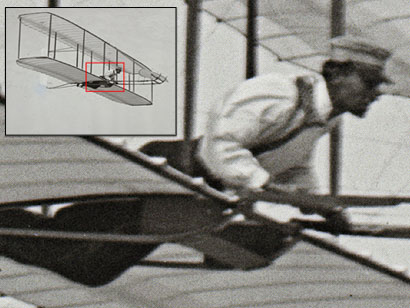
Reproducing an accurate 1902 Glider is a complex combination of detective work, engineering, and craftsmanship. The glider is critical—like the original, it will be used to train pilots to fly the 1903 Flyer. Although the 1902 Glider resembles their earlier machines, it was unlike any other machine the Wrights had built. Its design was based on solid, reliable data from their wind tunnel experiments.
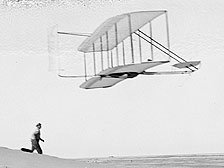
The Wrights’ original glider was designed from experience, calculations, and experiment. Building the reproduction glider means following a trail of clues and looking for undiscovered details. All that remains of the original 1902 glider is a fragment of a wingtip—the rest disintegrated into the sand. The Wright Experience used a lot of clues from the Wrights’ notes, detailed photographs, models, and computer-aided design to put together the 1902 puzzle.
The US Army drafted a set of plans for the glider in 1934, and Orville made some notations on them some thirty-two years after the glider was built. While these plans provide the fundamental framework of the aircraft, they are of limited value in producing an accurate reproduction of the glider.
Like all the Wright gliders, there are no original plans, so building a reproduction requires detailed study of the Wrights’ notes and letters about the machine. In the case of the 1902 glider, Orville and Wilbur both noted the machine’s basic dimensions, weight, and other details of its construction. These notes are the only primary accurate source of information about the glider’s design.
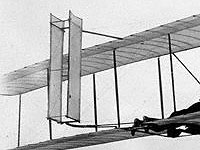
The photographs taken by the Wrights during the 1902 and 1903 gliding seasons are the most important original source of information about the glider. The Library of Congress has made high-resolution scans of the Wrights’ original glass plate images available to the public. From these images, new details of the glider have been seen with unprecedented clarity.
Using known measurements of major components of the glider, accurate measurements of the complete machine can be made from the photographs, verifying the accuracy of the existing plans or correcting earlier errors. For example, bracing wires from the aft wing spar to the rudder which are visible in the pictures are not recorded on the 1934 plans.
Scale models made of wood and digital models made of calculations—these indispensable tools are used to compare the accuracy of the reproduction glider with the photographs of the machine. They yield many surprises.
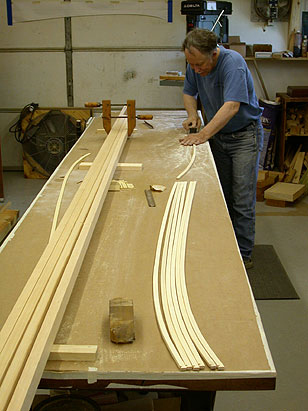
How was the 1902 Glider built? The Wright brothers manufactured the glider’s components in Dayton, but assembled and tested the machine in Kitty Hawk. Only then would they know if it worked.
Among the many changes from the 1901 glider was a vertical tail added at the rear of the 1902 glider. Its purpose was to correct a strange behavior of the 1901 glider: when the Wrights turned it to the left or right, it would start the turn, but then skid in the opposite direction! The Wrights had accidentally discovered the third axis of control: yaw.
The rudder started as a double-vaned, fixed attachment. While it clearly helped in turning the machine, a new problem arose, which the Wrights called “well digging”. In a turn, the glider would bank, with one wing higher and one lower. The problem was that it would then skid toward the lower wing.
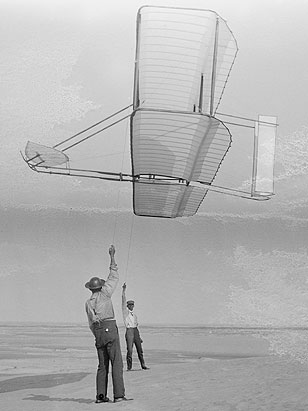
Orville deduced that making the rudder moveable would correct the problem. Wilbur took it further and attached it to the wing warping mechanism. A new single-vane, moveable rudder was attached. The solution worked, and the Wrights had the first fully controllable aircraft ever built.
The final change was to keep the rudder moveable, but return it to its double-vaned configuration. This provided more control, and with this machine, the Wrights completed over a thousand glides in preparation for the historic flights of 1903.
Ribs
The ribs and other wooden components of the 1902 glider are made from Sitka spruce, the closest available equivalent to the West Virginia spruce used by the Wrights. Each rib is notched at the front so the rib can be lashed to the leading edge spar, and at the rear so the fabric can be attached at the trailing edge. The ribs are bent to shape by being steamed and bent around a form.
Hip Cradle
The hip cradle is held in place by two metal bands which pivot and allow the cradle to be moved to the right or left, pulling on the cables of the wing warping mechanism and rudder assembly.
Wing Warping Pulley
An adaptation of the 1901 design, the pulleys of the wing-warping system are located at the lower wing next to the base of the outermost struts. The Wright brothers used a strong sash cord through the pulley for their gliders, moving to chain for the later powered machines.
Single-Vane Rear Rudder
The fabric for each component of the machine to be covered is carefully measured and cut before being applied to the structure.
Sewing the Fabric
The wing coverings are sewn as diagonal strips and then assembled into panels for each surface. There is no provision in the wing structure for strength in the diagonal direction, and the fabric provides this support.
Attaching the Fabric
The fabric is attached to the airframe primarily using pockets sewn into the panels that encapsulate the airframe itself.
Airframe
The airframe is completely assembled before the fabric is applied to ensure that all the components are properly fitted.
Finishing the Wings
Once the fabric is in place, the struts, wires, and top wing are put in place, and the canard and tail attached.
Final Assembly
Once assembled, the glider was tested in the wind tunnel and then used for pilot training. It was built to accommodate both the single and double vertical rudders.
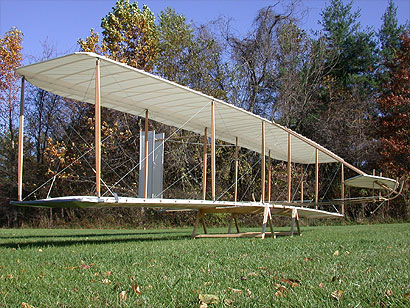
The 1902 Glider finally gave the Wrights what they had wanted all along—time in the air. Join the Wright Experience pilots as they learn first hand how to fly the machine. Like the brothers a century ago, the Wright Experience pilots must learn how to fly the 1902 glider. The glider was first tested in a wind tunnel to determine its flight characteristics experimentally. From this data, a flight simulator was built to give the pilots an initial feel for the aircraft.
The Wrights rarely described the thrill of flying. For them, it was all science. The “art” lay in performance: measurements of the wind speed, glide angles, distances, and duration in the air. Their success was in truly understanding the essence of flight.
The Wright brothers measured many of the flights of the 1902 glider, taking data for time, wind speed, distance covered, and the slope of the sand dune. From these measurements, they could calculate the airspeed (wind speed + ground speed, which is distance/time) of the glider, the lift-to-drag ratio, and other aspects of the glider’s performance. It is not known whether or not they compared this data with the predicted performance of the glider, but the results convinced them that they could build successful flying machines from the data they had recorded.
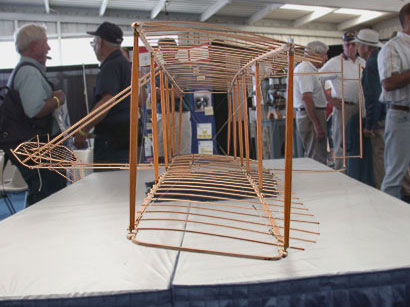
In June 2002, wind tunnel tests on the reproduction glider were carried out at the NASA/Langley Full Scale Wind Tunnel, operated by Old Dominion University. The tunnel tests confirmed the performance of the glider as reported by the Wrights, and enabled engineers to better measure its characteristics: its lift-to-drag ratio, best lift-to-drag speed, sink rate, and more.
Like the brothers a century ago, the Wright Experience pilots must learn how to fly the 1902 glider. The glider was first tested in a wind tunnel to determine its flight characteristics experimentally. From this data, a flight simulator was built to give the pilots an initial feel for the aircraft.
The pilots are now practicing flying the glider under the supervision of Scott Crossfield using a new method which gives them exactly what the Wrights were looking for: space, seclusion, and plenty of chances to fly. Our reproduction aircraft was tested at the NASA/Langley Full Scale Wind Tunnel in 2002. It was flown on the Outer Banks of North Carolina in 2002 and 2003 as part of pilot training for the 1903 Flyer.
Our 1902 Glider Reproduction and Pilot Training Sponsored by Northrop Grumman
